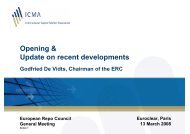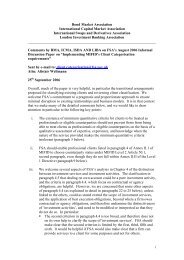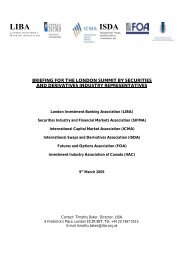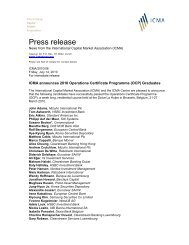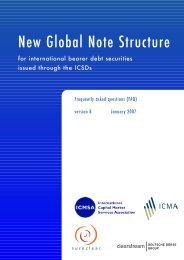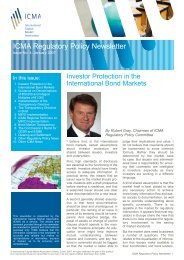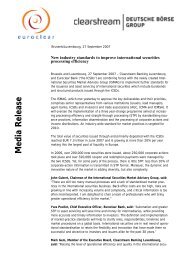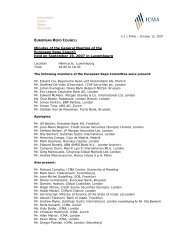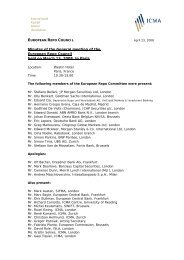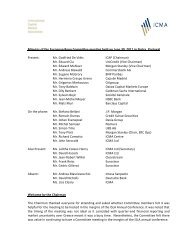Issue no. 22: ICMA Regulatory Policy Newsletter
Issue no. 22: ICMA Regulatory Policy Newsletter
Issue no. 22: ICMA Regulatory Policy Newsletter
Create successful ePaper yourself
Turn your PDF publications into a flip-book with our unique Google optimized e-Paper software.
Basel III liquid asset definition in the<br />
Liquidity Coverage Ratio – continued<br />
Furthermore, the fact that corporate and covered bonds<br />
must have a “proven record as a reliable source of liquidity<br />
in the markets (repo and sale) even during stressed market<br />
conditions” in order to be level 2 eligible is fairly limiting.<br />
The range of acceptable corporate or covered bonds will<br />
<strong>no</strong>t be flexible because it will take time to develop the<br />
required track record. Moreover, corporate and covered<br />
bonds may be liquid in some conditions but also typically<br />
have long maturities. On the other hand, commercial bills<br />
of exchange, for instance, have short maturities and can<br />
have intrinsic liquidity, but are <strong>no</strong>t eligible assets.<br />
Finally, it has been <strong>no</strong>ted that required liquid assets are<br />
<strong>no</strong>t liquid, but rather “locked” as they can<strong>no</strong>t be used<br />
by banks for internal use. In a crisis, the requirement<br />
could lead to central banks being forced to monetise<br />
government debt to avoid bank failures; while regulators<br />
need to be ready to release required liquid assets.<br />
A detailed list of assets that can be included in the stock<br />
of high quality liquid assets, together with some general<br />
considerations on the definition of liquid assets in the<br />
context of the LCR, has been provided by <strong>ICMA</strong> in a paper<br />
entitled Liquid Assets under the Liquidity Coverage Ratio,<br />
which was circulated to <strong>ICMA</strong> ECP and ERC Committee<br />
members in April. <strong>ICMA</strong> will be closely following the EU<br />
implementation of this element of Basel III.<br />
Contact: Serena Vecchiato<br />
serena.vecchiato@icmagroup.org<br />
SHORT-TERM MARKETS<br />
European repo market<br />
Liquidity rules: The Basel Committee has received a number<br />
of interpretation questions related to the December 2010<br />
publication of the Basel III regulatory frameworks for capital<br />
and liquidity and the 13 January 2011 press release on the loss<br />
absorbency of capital at the point of <strong>no</strong>n-viability. Publications<br />
released on 5 July set out the first set of Basel III frequently<br />
asked questions (FAQs), which relate to the definition of<br />
capital and the liquidity sections of the Basel III framework.<br />
Section 1 of the latter is particularly pertinent as it provides<br />
clarification on the calculation of the cap on Level 2 assets with<br />
regard to short term secured funding. A series of simple examples<br />
are laid out in respect of repo and reverse repo transactions.<br />
Eurepo – Eurepo Steering Committee members, four of whom<br />
are also <strong>ICMA</strong> ERC Committee members, have reviewed the<br />
Eurepo definition in order to adapt it to the predictable rise of<br />
its usage and visibility in the coming months, thereby further<br />
enhancing the accuracy of the benchmark. Consequently<br />
the Eurepo Steering Committee adopted the following<br />
revised definition: “Eurepo is the rate at which, at 11.00<br />
a.m. Brussels time, one bank offers, in the euro-zone and<br />
worldwide, funds in euro to a<strong>no</strong>ther bank if in exchange the<br />
former receives from the latter the best collateral within the<br />
most actively traded European repo market. It is quoted on a<br />
actual / 360 day basis.”<br />
Additionally, the Eurepo Code of Conduct, which was drafted<br />
in 2002, has been adapted to the current features of the<br />
benchmarks, as approved by Steering Committee members.<br />
The main changes are: (i) the deletion of Articles 4 (start-up<br />
number of panel banks) and 6 (rotation system); (ii) the<br />
adaptation of some wording to the present situation; and<br />
(iii) the inclusion of an exclusion rule for Steering Committee<br />
members in case of repeated <strong>no</strong>n-participation in Committee<br />
meetings. The new definition and the revised Code of<br />
Conduct entered into force on 11 April.<br />
European Commission review: The European Commission’s<br />
DG Markt has indicated its view that, alongside all the<br />
<strong>ICMA</strong> <strong>Regulatory</strong> <strong>Policy</strong> <strong>Newsletter</strong> Third Quarter 2011 | 17




